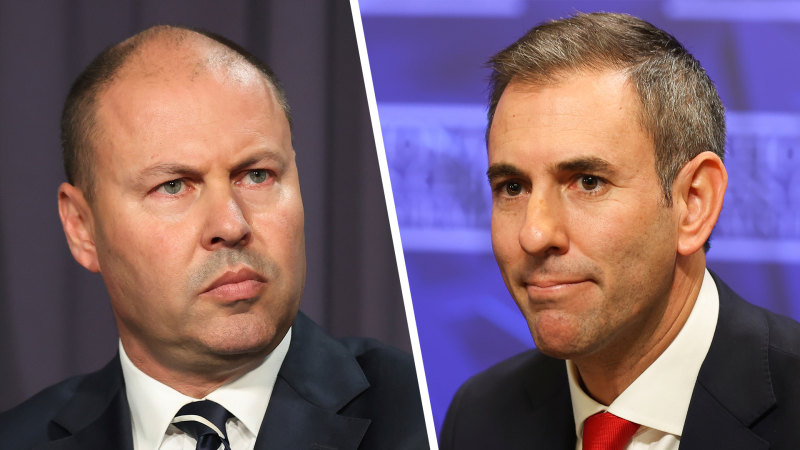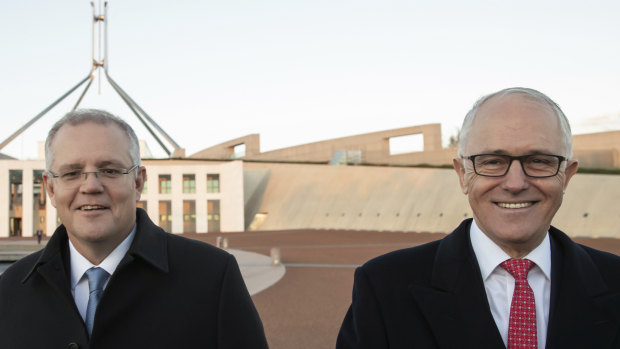Save articles for later
Add articles to your saved list and come back to them any time.
Next year’s stage three tax relief will still leave middle income wage earners up to $172 worse off in 2025 than they were in 2019, with independent analysis revealing bracket creep is eating into the pay packets of ordinary workers.
The analysis by economist Professor Ben Phillips from the Australian National University’s Centre for Social Research and Methods, shows that once the stage three tax cuts kick in next year, middle income households – those earning around $100,000 – will have less disposable income compared to 2019.
Then-treasurer Scott Morrison and then-prime minister Malcolm Turnbull after the 2018 budget which included a planned three stage tax plan. The benefits of the plan have been eaten by bracket creep for middle-income earners.Credit: Alex Ellinghausen
Phillips’ analysis tracked the impact of the original tax package first announced by then-treasurer Scott Morrison in his 2018-19 budget, and includes the welfare measures announced this week by Treasurer Jim Chalmers and the government’s ramp-up in childcare assistance.
Morrison said at the time the stage three cuts would “protect what Australians earn from bracket creep”. His successor, Josh Frydenberg, who increased the size of the tax cuts, also maintained they would protect people from the process by which a greater proportion of their income is taxed at a higher rate.
This week, Chalmers revealed the cost of the stage three tax cuts had continued to grow. They are now forecast to cost $69 billion over the next four years, including $21 billion in their first year of operation. They were originally expected to cost $15.7 billion in 2024-25.
Phillips’ analysis shows bracket creep had eaten into the tax plan’s purported benefits.
Including the changes announced in Chalmers’ budget, the bottom 20 per cent of households by income will be $390 better off in 2024-25 under all elements of the tax plan. The next 20 per cent, earning between $40,000 and $75,000, will be just $30 in front.
The top 20 per cent will be $3580 better off.
But the analysis shows there is a short-term financial benefit due to this week’s budget and the stage three tax cuts.
He found when just the stage three tax cuts and this week’s welfare measures are taken into account, all income groups have improved their financial position for this year and next only.
Over financial years 2023-2024 and the next, the bottom 20 per cent of households by income will enjoy a $509 or 1.7 per cent lift in their disposable income. Middle income earners will be $1243 or 1.8 per cent in front, while the top 20 per cent of earners will be 2.2 per cent or $5378 better off.
But the impact of bracket creep is so large, it wipes out this lift.
Phillips said the real value of the stage three tax cuts had fallen to just $6 billion since they were initially announced.
He said this week’s budget would deliver benefits to the unemployed and low-income renters while energy rebates would save households about $2.6 billion.
“These measures are targeted towards the lowest-income and most financially stressed households,” he said.
“(But) in combination with the stage three tax cuts, or the 10-year tax plan, the impact is more regressive and the dollar benefits flow heavily to higher income households.”
Chalmers said on Thursday that the budget provided substantial support for middle Australians while the government had also been trying to lift wages.
He said changes to bulk billing, the energy package and cheaper childcare would all help reduce cost of living pressures on middle income earners.
The Treasurer said dealing with bracket creep was a “worthy objective”, noting the stage three tax cuts delivered relief to people earning as little as $45,000 a year.
“Obviously these (tax cuts) are contentious. People have views on both sides of the argument, frankly, but our focus in this budget has been helping middle Australia and helping the most vulnerable through a difficult period at the same time as we invest in their future,” he said.
The independent Parliamentary Budget Office last year, in analysis on the budget’s long-term sustainability, noted that Australians faced paying the highest average tax rates on their wages on record without a major overhaul of the tax system.
It found low- to middle-income earners would likely face the largest increase in their average tax rates. Even the highest income earners, who gain the most from the stage three tax cuts, would ultimately face an increase in their average tax rate due to bracket creep.
Cut through the noise of federal politics with news, views and expert analysis from Jacqueline Maley. Subscribers can sign up to our weekly Inside Politics newsletter here.
Most Viewed in Politics
From our partners
Source: Read Full Article


